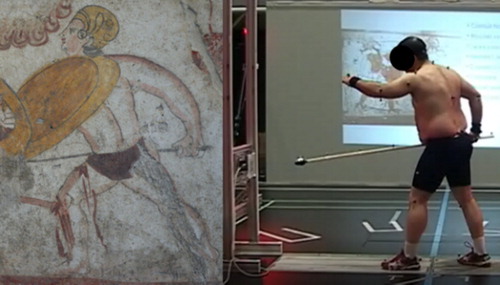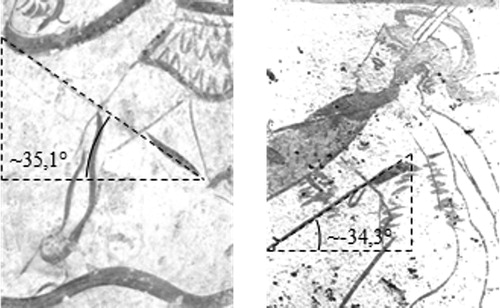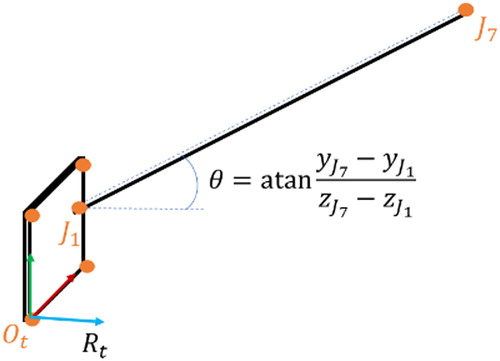 ?Mathematical formulae have been encoded as MathML and are displayed in this HTML version using MathJax in order to improve their display. Uncheck the box to turn MathJax off. This feature requires Javascript. Click on a formula to zoom.
?Mathematical formulae have been encoded as MathML and are displayed in this HTML version using MathJax in order to improve their display. Uncheck the box to turn MathJax off. This feature requires Javascript. Click on a formula to zoom.1. Introduction
It is important for historians to separate myth from reality. Experimental approaches are a reliable way to replay possible behaviors, manners, and gestures and evaluate their plausibility. It is particularly true for historical martial arts, trying to reproduce some of the practices and gestures represented in icons and texts.
During the funeral of Patroclus organized by Achilles, duels were organized between the princes and kings of the Greek coalition to honor his memory. This passage from the Iliad left its mark on Greek culture. It was at the origin of the funeral combats organized in Campania from the 4th BC. Stemming from the homeric tradition, the singular combats represent warriors who fight to honor the memory of a deceased at the risk, sometimes, of their life.
The Italic people (Campanians, Lucanians and Etruscans mainly) added from the middle of the 4th century BC the stages of the funeral of Patroclus to theirs. Paestum (former Poseidonia) was founded around 600 BC. The frescoes found on this site are the major source of iconographic single combat information’s of italic funeral rites.
The walls of the tombs of Paestum and its surroundings mention the events organized in this context. The iconographers thus testify to the presence of wrestling and chariot racing competitions as in Etruscan tombs but above all different types of duel combat. They relate clashes accompanied by one or more musicians and placed under the supervision of referees. Winners are rewarded as underlined by the presence of prizes in the background. The bruised and injured bodies of the duellists illustrate the will to be the best but also the fact that the stake of the combat exceeds the combatant. The glorified body of the combatant is subjected to the risks of combat to honor the memory of a deceased. The bloodshed, the commitment of the two warriors and the quality of the confrontation serve as gateways to the Chtonian deities. In such a context, the painted wounds seem exaggerated (pierced armors, through-body wounds) and fighters’ bodies oversized making it difficult to judge their realism (Potrandolfo & Rouveret Citation1992; Teyssier Citation2009).
To understand the plausibility of those representations, this pilot study reproduced some of the attack postures from the paintings of Paestum and analyzed them regarding their efficiency and their kinematics.
2. Methods
2.1. Experimental protocol
From the corpus of lucanian frescoes tomb paintings and the knowledge from ancient roman and greeks literatures, corresponding to this period of the antiquity, a subset of initial attack postures supposed to be the most historically and biomechanically plausible was extracted. Postures were extracted with regard to the attack type (high or low posture) and the type of weapon (spear or javelin). The targeted zone (upper or lower body) corresponded to a trunk or leg attack on a fighter of the size of the subject, that are the most represented wounds in the corpus ().
Figure 1. (left) Sample icon representative of a plausible low posture, low targetet zone and spear attack. (right) Initial posture of one trial, developed from the icon. The subject is hitting a force sensor, and is equipped with motion capture markers.

One subject participated in this pilot experimentation. He was 1.69 m tall and weighed 88 kg. He was a regular practioner of historical martial arts (2 hours per week for 8 years).
The subject was asked to repeat 5 attacks per condition, mixing posture, targeted zone and weapon in random order. The subject used weighted weapons representative from the weapons of this period (based on warriors tombs artefacts − 1.2 m/310g javelin and 1.5 m/350g spear). The subject placed himself at a distance he judged comfortable to hit the target with force and accuracy.
The target was a vertically transatable plexiglas 20cmx20cm target equipped with a 6 dofs force sensor (MC3A, AMTI). Motion of the subject was captured with a classical motion capture system (VICON, 24 cameras), following the ISB recommendations for the marker placement. Motion of the weapons and position of the target were recorded as well, thanks to additional markers placed on the corners of the target and the extremeties of the weapons.
2.2. Analysis
Efficiency: Impact forces (IF) were extracted for all trials, and motions of the weapons were computed from the marker positions. The weapon angles of incidence (AI) at the impact were computed from the markers positions using local frames reconstructions, as shown in . The impact time was detected by finding the minimal distance between the tip of the weapon and the target plan.
Kinematics: Subject data was analysed thanks to the CusToM toolbox (Muller et al. Citation2019). Joint angles for all trials were computed with a Levenberg-Marquardt inverse kinematics method applied to a scaled biomechanical model of the subject (42 dofs model). Ranges of motion (ROMs) for 5 of the armed limb joints were computed per trial. IF, AI, and ROMs were statistically investigated with repeated measures ANOVA, including a Greenhouse-Geisser sphericity correction. Independent variables were the subject posture, the target type and the weapon type. Tukey’s HSD was used for post-hoc tests. The confidence level was set to 0.01.
3. Results and discussion
Efficiency: Post-hoc tests revealed that IF was higher with the spear than with the javelin ( vs.
). AI was significantly different regarding the target and the posture, with an interaction between both conditions. AI for lower body targets was of
with low postures and about
with high postures, whereas it was, for upper body targets,
° for low postures and
for high postures.
Kinematics: Results are given for the ROMs. The shoulder elevation plane was not influenced by the target for low postures ( for all targets) whereas it was the case for high postures (
for lower body targets vs.
for upper body targets). The shoulder elevation and internal-external rotation were not influenced by the target for the high postures (
and
resp. for all targets), whereas it was the case for low postures (
and
resp. for lower body targets vs.
and
° resp. for upper body targets). Elbow flexion was significantly higher for high postures than for low postures (
vs.
as well as wrist flexion (
vs.
This pilot study is limited and can only give insights on the common interpretations usually proposed for these paintings. First, angles of incidence can be compared with some of the wounds represented in the paintings (see ). Such results can be used to confirm the plausible attack that caused this specific wound or he plausibility of the wound itself.
Figure 3. (left) Plausible high posture attack to the leg (right) Unplausible low posture attack to the trunk.

Kinematics presented interesting results, showing a larger involvement of the elbow and wrist for high postures attacks. This result may indicate motion variability that can be important for gesture adaptation. Results also showed a shoulder adaptation regarding the target for low postures attacks. Attacking a higher target may have led to a higher elevation plane amplitude instead of a change in the elevation and internal/external rotation. This adaptation may therefore be due to the accuracy asked to perform this attack.
A second study involving a larger cohort and more trained fighters is planned to understand more in detail the motion strategies involved in these attacks and their relevance. Last, an experimental study will evaluate the forces necessary to pierce ancient armor pieces replicas (linen and bronze protections) and compare them to the forces measured in this protocol to assess their plausibility.
Disclosure statement
No potential conflict of interest was reported by the authors.
References
- Muller A, Pontonnier C, Puchaud P, Dumont G. 2019. CusToM: a Matlab toolbox for musculoskeletal simulation. JOSS. 4(33):927.
- Potrandolfo A, Rouveret A. 1992. Le tombe dipinte di Paestum. Modena (Italy): Franco Cosimo Panini.
- Teyssier E. 2009. La Mort en face: Le Dossier gladiateurs. Arles (France): Actes Sud.

